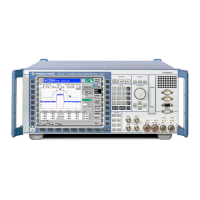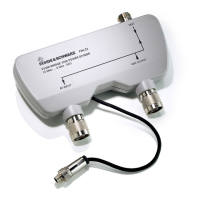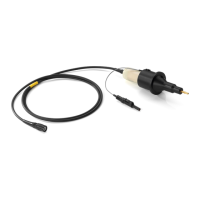CMU Program Examples
1100.4903.12 7.3 E-4
ibwrt(h_GSM900MS_Sig, "READ:SCAL:POW:RES?",18);
ibrd (h_GSM900MS_Sig, InBuffer,sizeof (InBuffer));
...
ibwrt(h_GSM900MS_Sig, "READ:SCAL:MOD:RES?",18);
ibrd (h_GSM900MS_Sig, InBuffer,sizeof (InBuffer));
...
// Example for a GSM1800 mobile with a power and
// modulation measurement at PCL 5 and PCL 10
ibwrt(h_GSM1800MS_Sig, "PROC:SIGN:MS:PCL 5",18);
ibwrt(h_GSM1800MS_Sig, "READ:SCAL:POW:RES?",18);
ibrd (h_GSM1800MS_Sig, InBuffer,sizeof (InBuffer));
...
ibwrt(h_GSM1800MS_Sig, "READ:SCAL:MOD:RES?",18);
ibrd (h_GSM1800MS_Sig, InBuffer,sizeof (InBuffer));
...
ibwrt(h_GSM1800MS_Sig, "PROC:SIGN:MS:PCL 10",19);
ibwrt(h_GSM1800MS_Sig, "READ:SCAL:POW:RES?",18);
ibrd (h_GSM1800MS_Sig, InBuffer,sizeof (InBuffer));
...
ibwrt(h_GSM1800MS_Sig, "READ:SCAL:MOD:RES?",18);
ibrd (h_GSM1800MS_Sig, InBuffer,sizeof (InBuffer));
Measuring the I/Q Spectrum of a Mobile
GSM uses the GMSK modulation scheme with a symbol rate of 270.833 kBit/s and four different
phases that can be occupied during one symbol interval. If a constant series of zeros or ones is
transmitted, the rotation of the I/Q vector causes a side band at 270.833/4 Hz = 667.70825 Hz from the
carrier. Compared to the side band, the original carrier frequency is suppressed by –30 dB to –40 dB.
The following example program measures the carrier signal, the upper and the lower side band using
the RF Spectrum and the RF Power vs Time measurement groups. No additional options are needed.
To keep the syntax as short and simple as possible, the programs were written with the aid of
Winbatch, a batch job tool organizing and simplifying the transfer of commands and data between the
controller and the instrument.
Winbatch uses device names such as CMUBASE, CMUGSMNS, CMUGSMSIG which are previously
defined and assigned to the primary address, secondary address, and some general device settings.
With these device names, a complete command line reads:
CMUBASE: <CMU_Command>
where <CMU_Command> may be any of the commands (setting commands or queries) specified within
the function group and mode identified by the device name CMUBASE. Program sequences consisting
of commands that are defined in several function groups and modes can be re-used with an exchanged
device name.
In addition to these data transfer commands, Winbatch provides WHILE, GOTO, and IF statements to
express conditions and define loops. Program examples utilizing these statements can be found in the
manuals for network tests, e.g. GSM900/1800/1900-MS. For the following example, configure your
Winbatch settings such that CMUBASE is the device name for the CMU BASE system and CMURF
denotes function group RF (Non Signalling).

